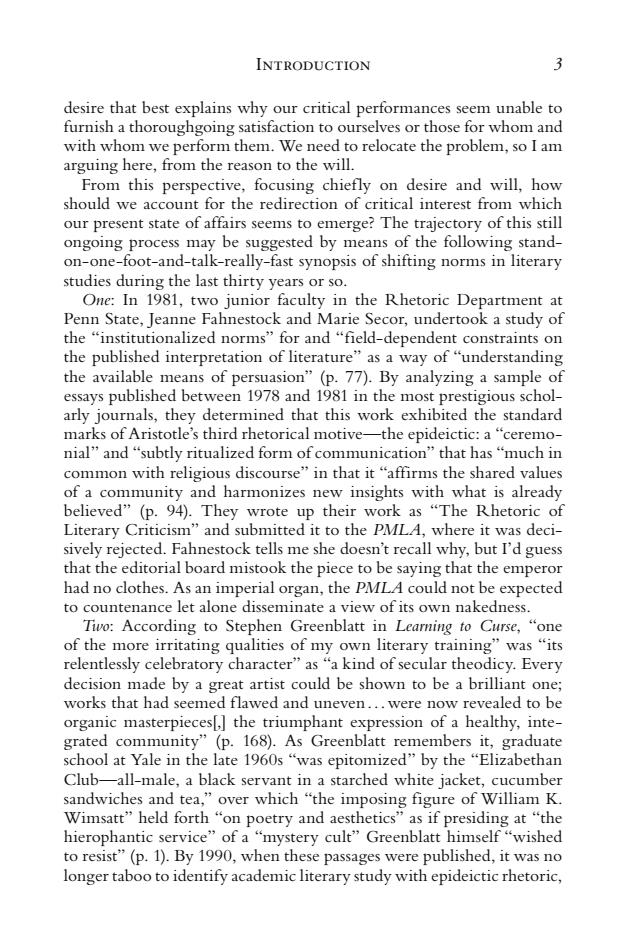正在加载图片...

INTRODUCTION 3 desire that best explains why our critical performances seem unable to furnish a thoroughgoing satisfaction to ourselves or those for whom and with whom we perform them.We need to relocate the problem,so I am arguing here,from the reason to the will. From this perspective,focusing chiefly on desire and will,how should we account for the redirection of critical interest from which our present state of affairs seems to emerge?The trajectory of this still ongoing process may be suggested by means of the following stand- on-one-foot-and-talk-really-fast synopsis of shifting norms in literary studies during the last thirty years or so. One:In 1981,two junior faculty in the Rhetoric Department at Penn State,Jeanne Fahnestock and Marie Secor,undertook a study of the "institutionalized norms"for and"field-dependent constraints on the published interpretation of literature"as a way of"understanding the available means of persuasion"(p.77).By analyzing a sample of essays published between 1978 and 1981 in the most prestigious schol- arly journals,they determined that this work exhibited the standard marks of Aristotle's third rhetorical motive-the epideictic:a "ceremo- nial”and“subtly ritualized form of communication'”that has“much in common with religious discourse"in that it"affirms the shared values of a community and harmonizes new insights with what is already believed"(p.94).They wrote up their work as "The Rhetoric of Literary Criticism"and submitted it to the PMLA,where it was deci- sively rejected.Fahnestock tells me she doesn't recall why,but I'd guess that the editorial board mistook the piece to be saying that the emperor had no clothes.As an imperial organ,the PMLA could not be expected to countenance let alone disseminate a view of its own nakedness. Two:According to Stephen Greenblatt in Learning to Curse,"one of the more irritating qualities of my own literary training"was"its relentlessly celebratory character"as"a kind of secular theodicy.Every decision made by a great artist could be shown to be a brilliant one; works that had seemed flawed and uneven...were now revealed to be organic masterpieces[,]the triumphant expression of a healthy,inte- grated community"(p.168).As Greenblatt remembers it,graduate school at Yale in the late1960s“was epitomized”by the“Elizabethan Club-all-male,a black servant in a starched white jacket,cucumber sandwiches and tea,"over which"the imposing figure of William K. Wimsatt'”held forth“on poetry and aesthetics”as if presiding at“the hierophantic service'”ofa“mystery cult'”Greenblatt himself“wished to resist"(p.1).By 1990,when these passages were published,it was no longer taboo to identify academic literary study with epideictic rhetoric,Introduction 3 desire that best explains why our critical performances seem unable to furnish a thoroughgoing satisfaction to ourselves or those for whom and with whom we perform them. We need to relocate the problem, so I am arguing here, from the reason to the will. From this perspective, focusing chiefly on desire and will, how should we account for the redirection of critical interest from which our present state of affairs seems to emerge? The trajectory of this still ongoing process may be suggested by means of the following standon-one-foot-and-talk-really-fast synopsis of shifting norms in literary studies during the last thirty years or so. One: In 1981, two junior faculty in the Rhetoric Department at Penn State, Jeanne Fahnestock and Marie Secor, undertook a study of the “institutionalized norms” for and “field-dependent constraints on the published interpretation of literature” as a way of “understanding the available means of persuasion” (p. 77). By analyzing a sample of essays published between 1978 and 1981 in the most prestigious scholarly journals, they determined that this work exhibited the standard marks of Aristotle’s third rhetorical motive—the epideictic: a “ceremonial” and “subtly ritualized form of communication” that has “much in common with religious discourse” in that it “affirms the shared values of a community and harmonizes new insights with what is already believed” (p. 94). They wrote up their work as “The Rhetoric of Literary Criticism” and submitted it to the PMLA, where it was decisively rejected. Fahnestock tells me she doesn’t recall why, but I’d guess that the editorial board mistook the piece to be saying that the emperor had no clothes. As an imperial organ, the PMLA could not be expected to countenance let alone disseminate a view of its own nakedness. Two: According to Stephen Greenblatt in Learning to Curse, “one of the more irritating qualities of my own literary training” was “its relentlessly celebratory character” as “a kind of secular theodicy. Every decision made by a great artist could be shown to be a brilliant one; works that had seemed flawed and uneven ... were now revealed to be organic masterpieces[,] the triumphant expression of a healthy, integrated community” (p. 168). As Greenblatt remembers it, graduate school at Yale in the late 1960s “was epitomized” by the “Elizabethan Club—all-male, a black servant in a starched white jacket, cucumber sandwiches and tea,” over which “the imposing figure of William K. Wimsatt” held forth “on poetry and aesthetics” as if presiding at “the hierophantic service” of a “mystery cult” Greenblatt himself “wished to resist” (p. 1). By 1990, when these passages were published, it was no longer taboo to identify academic literary study with epideictic rhetoric